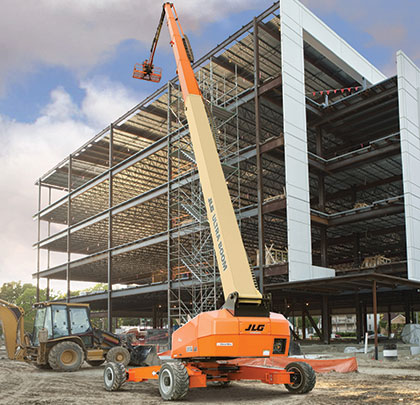The right tool for the job” is a well-worn construction industry cliché, but it’s true nonetheless. Whether it’s a wrench or an aerial work platform (AWP), using the right tool typically improves safety and productivity. Knowing more about AWP choices and how to match them to the task at hand will benefit workers and companies.
ASSESS THE JOB
To get the most out of a lift and ensure its safe operation, construction leaders should first choose the proper equipment and then make sure that all operators are trained on its use. Selecting the right machine means asking key questions about the work to be performed:
- Will you be working indoors or outdoors?
- How high do you need to go?
- What are the jobsite conditions? Do they include uneven surfaces and/or obstacles to work over or around?
- How many people will be working with you?
- What tools are necessary to perform the task?
- Will you need to move around the jobsite?
- Must the lift fit through doorways?
- Do you need any special equipment at height, such as welding equipment or other similar tools?
BOOMS AND SCISSORS
Different types of equipment offer unique capabilities, benefits, and uses. Boom lifts, for example, are designed to reach maximum heights. Contractors can choose from articulating and telescopic models, depending on the demands of the job.
Articulating boom lifts provide up-and-over access to heights ranging from 34 to 125 feet. They represent the lift-of-choice to overcome immovable objects or structural obstacles. Most platforms feature a 500-pound capacity to accommodate multiple workers and various tools and equipment. They are available in electric-, gas-, and diesel-powered models; hybrid lifts can use electric and diesel or gas, and can therefore be used indoors or outdoors.
When horizontal reach is more important than up-and-over access, the telescopic boom lift is a good choice. These lifts are designed for maximum horizontal and vertical outreach, with heights up to 185 feet, making them ideal for multi-story building or high-rise access.
While booms allow access outside of the machine’s footprint, scissor lifts are limited to an area almost entirely within the machine’s footprint. That tradeoff, however, is offset by platforms that typically provide more work space and greater capacities. They are effective when there is unobstructed access and for work directly overhead. The lifts are well-suited for both interior and exterior applications that require reach heights ranging from approximately 25 to 53 feet, and are available in electric and combustion versions.
Platform sizes of scissor lifts vary. Narrow platforms can navigate to more places, while wider platforms accommodate more parts, tools, and equipment. Larger scissor lifts can handle up to 2,250 pounds. Despite their larger platforms and capacities, scissor lifts typically have narrow footprints, so many of them can fit through standard commercial doorways and into elevators.
SMALLER LIFTS FOR SMALLER SPACES
Smaller, electric-powered mast lifts feature a more compact platform, can carry up to 500 pounds, and reach as high as 32 feet. In addition, some models are equipped with a 360-degree rotating mast and up to 14 feet of jib reach to provide access up, over, and around shelving, ductwork, and other obstacles.
With a tighter turning radius, these smaller lifts are best suited for limited workspaces, such as narrow hallways, walkways, or aisles. They are the lift-of-choice for basic maintenance, repair, and inspection tasks, as their size makes them portable, storable, and unobtrusive in the work environment. They are powered by environmentally friendly electric-powered drive systems, and feature non-marking rubber tires for indoor use.
Compact crawler boom (CCB) lifts use non-marking tracks instead of tires, which combine with a low profile and compact dimensions to make these machines good choices for work indoors. The tracks allow these machines to traverse up and down stairs, as long as the slope does not exceed the manufacturer’s specification for safe operation. Working heights range from 45 to 76 feet, and a hydraulic jib puts more projects within the operator’s reach, particularly in atriums and auditoriums. What’s more, the machines are as narrow as 2 feet, 7 inches, so they easily fit through most standard commercial doorways, aisles, hallways, gates, and other tight spaces.
Environmentally friendly CCB lifts feature standard AC power. Rechargeable batteries mean the machines do not need to be plugged into a power source, increasing freedom of movement around a facility. Some manufacturers offer an optional, emissions-free Lithium-ion electrical system. And because the design disperses the machine’s weight across a wide area, CCB lifts can be set up on sensitive flooring and landscaping.
Additionally, one-touch outrigger leveling enables users to level the machines for work on uneven surfaces.
ACCESSORIES INCREASE PRODUCTIVITY
In addition to their reach and access capabilities, lifts offer tools and accessories to increase productivity while improving jobsite safety. Platforms can also be equipped with workstations that include welding units, storage bays for parts and hardware, saw and drill ports, rail-mounted vises, and light towers for illumination. Some also feature a 12-volt outlet on the platform, which makes using rechargeable tools easy. Newer boom lifts incorporate electric, air, and water lines inside the boom, and onboard generators offer uninterrupted tool operation when the lift is moved.
AWPs are a tremendous asset for common tasks performed by contractors. When properly selected, maintained, and operated by trained, qualified personnel, they can provide safe access to work areas that might otherwise be impossible to reach. ■
About The Author:
Corey Raymo is a global product director, aerial work platforms, with JLG Industries, Inc. For more information, visit www.jlg.com.
_________________________________________________________________________
Modern Contractor Solutions, February 2015
Corey Raymo is a global product director, aerial work platforms, with JLG Industries, Inc. For more information, visit www.jlg.com.



